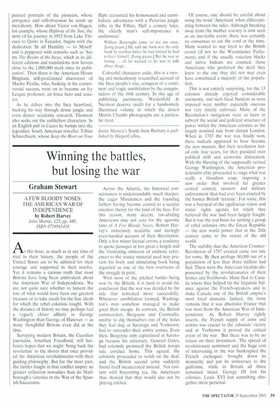Last lost land
Justin Marozzi
THE WHITE ROCK by Hugh Thomson Weidenfeld & Nicolson, £20, pp. 277, ISBN 0297842447 Explorers are an endangered species these days. The relentless march of modernisation has by and large rendered them obsolete. Empty spaces on maps have been gobbled up by men like Sir Wilfred Thesiger. The world's 14 greatest mountains have been scaled by one man. Yachtsmen and women have crossed the high seas. Even the Arctic and Antarctic have been traversed so many times we groan in boredom at the latest account of a onelegged single mum hopping to the North Pole with live hourly web casts. Put away the dusty maps, the compasses and the walking boots, comes the cry. Satellites and scientists are the order of the day.
The demise of the explorer has dealt a serious blow to his stock in trade, the travel book. Travel writing, for long despised by the critics and increasingly regarded as a decadent and superannuated genre, has had to reinvent itself. It is no longer enough to go somewhere, have a few adventures and describe the natives to the folks back home (Bill Bryson, the bestselling Wilbur Smith of travel writing, being the exception that proves the rule). Travel to exotic parts is no longer the explorer's preserve.
It is a measure, then, of Hugh Thomson's skills as a writer, historian and explorer that The White Rock is such a pleasure. Peru, one of the few places on earth whose innermost depths are still terra incognita, is fertile territory for the travel writer in search of the unknown, on the trail of the 'other'. Certainly, as Thomson argues, its innermost depths of jungle and mountain will continue to surprise in the 21st century, offering ever more discoveries that shed new light on the Incas and their empire.
Thomson approaches his adventurous journeys to the lost cities of Peru, Bolivia and Ecuador with admirable understatement and lightness of touch. Much of The White Rock is in fact a fascinating history of South American exploration, with well penned portraits of the pioneers, whose arrogance and self-obsession he sends up mercilessly. How about Victor von Hagen, for example, whose Highway of the Sun, the story of his journey in 1952 from Lake Titicaca to Quito in Ecuador, begins with the dedication 'In all Humility — to Myself' and is peppered with remarks such as 'See my The Realm of the Incas, which in its different editions and translations now hovers close to the 1,000,000 mark since its publication'. Then there is the American Hiram Bingham, self-proclaimed discoverer of Machu Picchu, who, basking in his controversial success, went on to become an Ivy League professor, air force hero and senator.
As he delves into the Inca heartland, hacking his way through dense jungle and even denser academic research, Thomson also seeks out the unlikeliest characters. In an English pub in Cuzco he bumps into the legendary South American traveller Tobias Schneebaum, whose Keep the River on Your Right recounted his homosexual and cannibalistic adventures with a Peruvian jungle tribe in the Fifties. Half a century later, the elderly man's self-importance is undimmed:
William Burroughs came to see me once. [Long pause.] He said my hook was the only book by another writer he had wished he had written himself. [Long pause.] But he was so horinc. ... all he wanted to do was to talk about drugs.
Colourful characters aside, this is a moving and meticulously researched account of the Inca people's rise, conquest of a continent and tragic annihilation by the conquistadors of the 16th century. In this age of publishing parsimony, Weidenfeld & Nicolson deserve credit for a handsomely illustrated volume in which the dozen Martin Chambi photographs are a particular treat.
Justin Marozzi's South from Barbary is published by HarperCollins.







































































 Previous page
Previous page